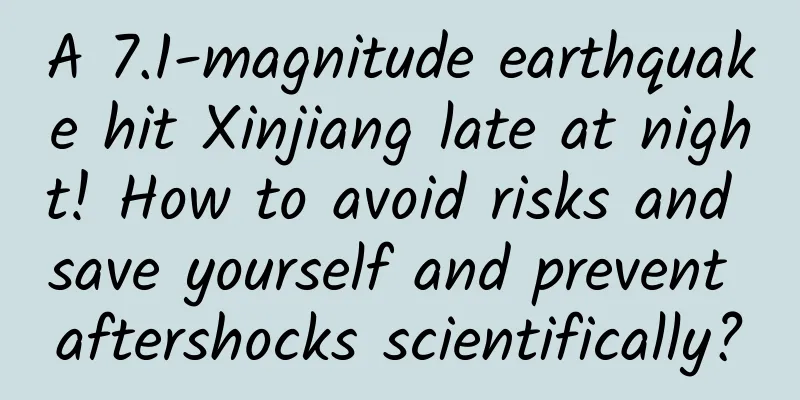A 7.1-magnitude earthquake hit Xinjiang late at night! How to avoid risks and save yourself and prevent aftershocks scientifically?

|
The China Earthquake Networks Center officially determined that at 2:09 a.m. on January 23, a magnitude 7.1 earthquake occurred in Wushi County, Aksu Prefecture, Xinjiang (41.26 degrees north latitude, 78.63 degrees east longitude), with a focal depth of 22 kilometers. Image source: China Earthquake Networks Center Strong earthquakes were felt in many places and aftershocks continued According to @中国地震网络网快报, the earthquake caused strong tremors in the surrounding areas. Aksu, Atushi, Kashgar, Yili, Korla, Karamay and other places felt strong tremors . Urumqi also reported tremors. During the earthquake, the staff of Wushi County Media Integration Center said that the earthquake in the county was strong. It felt that the 6-story media integration center shook for about 1 minute. The night shift staff quickly evacuated the building. People in many communities in the county were evacuated urgently. Some residents said that even the chandelier in the living room fell down. At present, the temperature in the county is minus 10 degrees Celsius. Image source: China Earthquake Networks Center As of 4 a.m., a total of 14 aftershocks of magnitude 3.0 or above were recorded near the epicenter. The largest aftershock was 5.3, about 17 kilometers away from the epicenter of the main earthquake. As of 6:00 today, three people were injured in Kulansarik Township, Aheqi County, Kizilsu Kirgiz Autonomous Prefecture, 26 kilometers away from the epicenter, and have been sent to the hospital for treatment in time; Wushi County has not received any reports of casualties so far. In the early morning of January 23, staff from the State Grid Aheqi County Power Supply Company set up lighting equipment at the temporary resettlement site in Aheqi County. Image source: Xinhua News Agency (Photo by Man Suer) After the earthquake, the advance forces of the Xinjiang Fire Rescue Corps and the Forest Fire Corps rushed to the epicenter and the surrounding areas to survey the situation. At present, the autonomous region has launched the second-level earthquake emergency response, and personnel from emergency, earthquake, transportation and other departments have rushed to the scene to guide the earthquake relief work. Earthquakes are short-lived events, and the basic principle of emergency earthquake avoidance is to "take shelter on the spot during an earthquake and evacuate quickly after an earthquake." Can you escape outdoors immediately after an earthquake? Can you hide in a wardrobe or other furniture? Can you lie down on the ground or wait for rescue? This earthquake self-help guide must be understood ↓↓↓ Image source: Ministry of Emergency Management More importantly, strong earthquakes often trigger a series of secondary disasters, and the situation may continue to deteriorate. According to statistics, landslides and other secondary disasters are currently the most common secondary disasters causing casualties . There are two main types of areas prone to earthquake secondary disasters: The first category is next to cliffs, alluvial fan areas, deep in mountain gullies, on the banks of large rivers, and on flat lakesides and shores. These places are prone to secondary disasters such as landslides, collapses, ground subsidence, ground fissures, uneven settlement, barrier lakes, and mudslides during earthquakes. The second category is areas with soft soil and liquefied soil, protruding strips of mountain spurs, towering isolated hills, steep slopes and bluffs, edges of river banks and slopes, areas with structural cracks, and soil layers with uneven origin and lithology (including ancient river channels, loose fault fracture zones, buried pondside valleys), etc. These places are prone to secondary disasters such as surface collapse, sand liquefaction, dislocation and cracks during earthquakes. In addition, there are also fires, epidemics, etc. caused by the destruction of building facilities. (1) Some buildings did not collapse during the main earthquake, but may collapse during aftershocks. Do not approach or use houses that have not been safety-certified to avoid secondary damage. (2) Check for damage to gas pipes, electrical wires, and water pipes. If you smell gas or see a broken pipe, turn off the main valve of the gas pipe from outside the house. Do not light a match to look for gas leaks. Do not touch fallen wires or damaged electrical appliances. (3) If you encounter a landslide, you should flee in the direction perpendicular to the direction of the landslide. In the landslide accumulation area, you should run to high ground on both sides. Do not run to the mountain opposite the landslide. If you hear the sound of a debris flow or a debris flow alarm, immediately flee to the mountainous areas on both sides of the main river. (4) Pay close attention to aftershock information, be careful to prevent earthquake rumors, and do not believe in information released through informal channels. Stay calm in times of danger, avoid risks scientifically, and stay safe! Comprehensive sources: Xinhua News Agency, CCTV News, China Earthquake Networks Center, Ministry of Emergency Management Education Center, etc. |
<<: Toxic and carcinogenic, the harm is comparable to gutter oil! Many families still use it to cook
>>: Use day cream during the day and night cream at night? Can I use whatever I want?
Recommend
Android crashes and pops up system messages, netizens provide temporary solutions
[[407114]] Recently, many Android users have enco...
Sold for over 200,000 RMB, this may be the most expensive hair in the world
(Public Domain) Recently, a media article stated ...
I’ve tried it for everyone and found that the “20-minute park effect” really works!
I wonder if you have seen the 20-minute park theo...
Short dramas about middle-aged and elderly people are going viral! Are our parents falling for the "50-year-old boss sweet drama"?
In recent months, short dramas about middle-aged ...
Learn from Wang Sicong’s marketing skills behind the scenes of the “Chongding Conference”
These days, if students who are engaged in market...
Data Snake · Taobao's eight spiral gameplays, you can close your eyes and follow the eight spiral gameplays to do it directly and roughly.
Data Snake · Taobao's eight spiral gameplays,...
No longer putting new wine in old bottles, Xunlei Transformation Concept submits IPO application again
On May 24, it was reported that Xunlei had resubm...
Electric Technology Car News: Is the powerful and low-priced Emgrand GL worthy of Chinese quality manufacturing?
Many people have encountered this situation. They...
8 bottom navigation bar design tips extracted from mainstream overseas products
Hello everyone, I am Clippp. Today I will introdu...
Will vegetables lose their nutrition if they are blanched? You may have never blanched these 6 types of food correctly
"Blanching vegetables will lose a lot of nut...
E-commerce operations: Social marketing product planning for e-commerce promotions (with practical examples from large companies)
How to organize a complete marketing campaign? Cl...
Case | Tencent’s advertising data sharing for advertisers’ reference!
Today, the editor will share with you the data of...
Users no longer like to buy your product? Try these 3 strategies
A product may be very popular at the beginning, b...
Which additive in soy sauce is more terrible? How to choose soy sauce
During the holidays, several acquaintances and fr...
How to operate a product in Jianshu
1. Product positioning Jianshu is a product that ...









